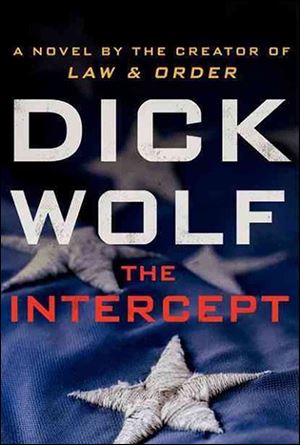
Wolf’s debut thriller reads like a screenplay
1/20/2013
The Intercept by Dick Wolf (William Morrow; 387 pages, $27.99)
Early in The Intercept, the serviceable debut thriller from Law & Order creator Dick Wolf, Osama bin Laden appears, reproaching his followers for recent failures.
“Bomb this. Bomb that,” he scolds the men, sounding like an ad executive in a branding meeting. “Nothing original, nothing intelligent,” adding, “We have failed to innovate.”
There’s a boldness in ventriloquizing such a figure, but if you’re going to do it, you’d better do it convincingly and with a full understanding of its historic weight.
You fear the book will never recover. But recover it does, for long stretches. Part police procedural and part ticking-bomb thriller, The Intercept jumps years ahead to offer us a New York City under imminent threat. In the days leading up to a Fourth of July dedication ceremony at the completed Freedom Tower, a group of passengers and a flight attendant prevent a hijacking, skyrocketing them to instant celebrity status as “the Six.”
Fortunately, Jeremy Fisk of the intelligence division of the New York City police, his cop brain unsullied by the bureaucratic and political distractions of the feds, comes to believe that the hijacking was merely a diversion and determines to uncover the real target.
For the first third of the book, including a promising passage in which investigators systematically break down a bunker of material seized after bin Laden’s death, it feels as if we are embarking on a brainy, topical thriller. The hybrid cop-intel lingo (using Patriot Act as a verb) and new technologies (like digital steganography) provide a sense of insiderdom. Wolf also has fun with petty intrigues and jealousies among the Six, holed up in the Grand Hyatt New York to be trotted out for the media as America’s latest overnight heroes.
Soon, however, the gears shift noisily, as the novel gives way to the suspect hunts, near misses, and red herrings more at home in a standard detective novel. Moreover, regular thriller readers will identify both the “mole” and the target early.
Given Wolf’s facility with even thumbnail sketches of minor characters and a particularly poignant study of a lonely American woman turned martyr, Fisk is a remarkably featureless hero, which makes the romantic relationship meant to undergird the tale feel superfluous. (Phrases like “her gym-hard body” in a love scene don’t help.) Most critically, however, Wolf cannot pull off a vital set piece toward the end, which lacks both emotional heft and genuine suspense.
The result is that we frequently feel as if we were reading a screenplay, with scenes and dialogue and mechanical crosscutting but no dramatic weight — and no novelty. Not surprisingly, Wolf recently said in an NPR interview that when he gave The Intercept to his 25-year-old son to read, his response was, “’Pretty good, Dad, but it reads an awful lot like a script.’” Wolf added, “I said, ‘Thank you!’”
There may have been a time, as the Cold War receded, when it was enough (and even exciting) to have a thriller that felt like a screenplay, with tight dialogue and a series of escalating set pieces linked by familiar character types (the rules-breaking cop, the thickly accented double agent).
But in recent years our expectations have risen. This is partly thanks to twisty, sophisticated novels by writers like Olen Steinhauer and Alex Berenson, but the primary reason is, paradoxically, thanks to movies and TV itself.
In thinking-man’s thrillers such as Argo and Zero Dark Thirty and the vaunted Showtime series Homeland, screenwriters are increasingly dramatizing real or close-to-real events with suspense-fiction techniques (frantic pacing, reversals), while enriching them with moral ambiguity or surprising us with untraditional protagonists who challenge our sympathies (although how long will it be before the obsessive, unstable female lead becomes a cliche?). In all these instances, factual events are used not just to render the stories current but also to make them more resonant; the stakes are raised by what we see in the world around us. We bring half the dread.
The Intercept never fully embraces this opportunity, remaining more comfortably ensconced in the immediately knowable characters, reliable plot beats, and crisp and clear moral universe we know so well from Law & Order.
To return, then, to the bin Laden of The Intercept: In portraying the mastermind of the Sept. 11 attacks as settling himself on a pair of cushions in his Abbottabad compound, berating his legions as though they were “students caught brawling,” was Wolf trying to cut such a figure down to size, to render him pedestrian, and strip him of his power?
If so, there’s no payoff. Why not have it matter more than the novel’s cameos from Matt Lauer and Mayor Michael Bloomberg?
Consider the bin Laden of Zero Dark Thirty. When the “white whale” finally makes his fleeting appearance in the film’s final minutes, we might almost miss him. We never hear him speak, never see him move. This towering figure who has changed the course of all our lives is both everything and, suddenly, nothing. He’s a man on the floor, dead.
PUBLICATION NOTES:
‘THE INTERCEPT: A Jeremy Fisk novel’
By Dick Wolf
387 pages. William Morrow. $27.99